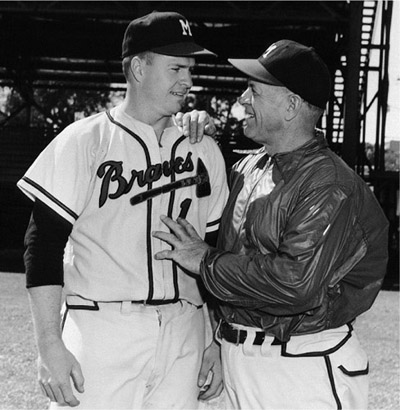
Braves catcher Del Crandall with manager Charlie Grimm (ROBERT KOEHLER COLLECTION)
“The Miracle of Milwaukee” far exceeded anything I could have imagined while growing up in Southern California. When the Braves franchise moved to Milwaukee in 1953, they were hoping to draw a few more people and make a little more money than they had in Boston. Little did we players realize how tremendous Milwaukee would be as a baseball town, from the first moment we stepped off the train and were greeted by thousands of fans. Many of the Braves were young, like Eddie Mathews and Billy Bruton. Others, like myself and Bob Buhl, had just gotten out of the service. And a handful of veterans, like Warren Spahn and Andy Pafko, were reinvigorated by the community support.
The reception we received from Milwaukee went far beyond the gifts of loaned cars from Wally Rank, milk from Golden Guernsey, meat from Kroeger, and dry-cleaning from Spic ’n’ Span. It was the people who made us all feel very special. Regardless of how many World Series titles or attendance records have been broken by a franchise before or since, that relationship between a community and a team will never be duplicated. Milwaukee Braves: Heroes and Heartbreak immediately took me back to all those wonderful years of my life. When you read this book, you’ll relive the great times in Milwaukee when baseball was the only game in town and people came out in droves to watch us play.

Braves catcher Del Crandall with manager Charlie Grimm (ROBERT KOEHLER COLLECTION)
On the field, our manager, Charlie Grimm, was the perfect fit for the Braves during those first few years in Milwaukee. He really knew how to mold us into winners by keeping the clubhouse light and not being very demanding. Us hardnosed players didn’t need daily pep talks, so he just let us go out and perform. Although Charlie was not around to lead us into the World Series, we were all tremendously grateful for the opportunities he provided us to grow into Major Leaguers. In 1956, Fred Haney took the reigns from Charlie and was just what we needed. He demanded a lot from us as maturing ballplayers and guided us to a World Series victory in 1957. He knew how to polish us into champions.
Milwaukee Braves: Heroes and Heartbreak will take you on a journey through those glory years—as well as when things started to fall apart. It was obvious to all of us in the clubhouse that something wasn’t quite right with Milwaukee baseball after we won the 1957 World Series. But even with the front office’s recalibrated approach towards replenishing the aging roster, the beer ban at County Stadium, and the arrival of new ownership, none of us could’ve predicted the Milwaukee Braves’ eventual fate. I remember when I had been traded and came back as a member of the Giants and Pirates, it was obvious the Braves were in a lame-duck situation while rumors swirled about their eventual departure for Atlanta in 1966. As someone who truly cherished his years as a resident of Brookfield, Wisconsin, during my playing days, it broke my heart to witness the final days of the Braves in Milwaukee.
You don’t have to be a Milwaukee Braves fan to appreciate Milwaukee Braves: Heroes and Heartbreak. Anybody who enjoys baseball, has an appreciation for the cultural significance of professional sports, or calls Wisconsin home will enjoy reading how the Braves became the team that made Milwaukee famous.
—Del Crandall
Milwaukee Braves catcher from 1953 to 1963
Team captain
Eight-time All-Star
Four-time Gold Glove winner